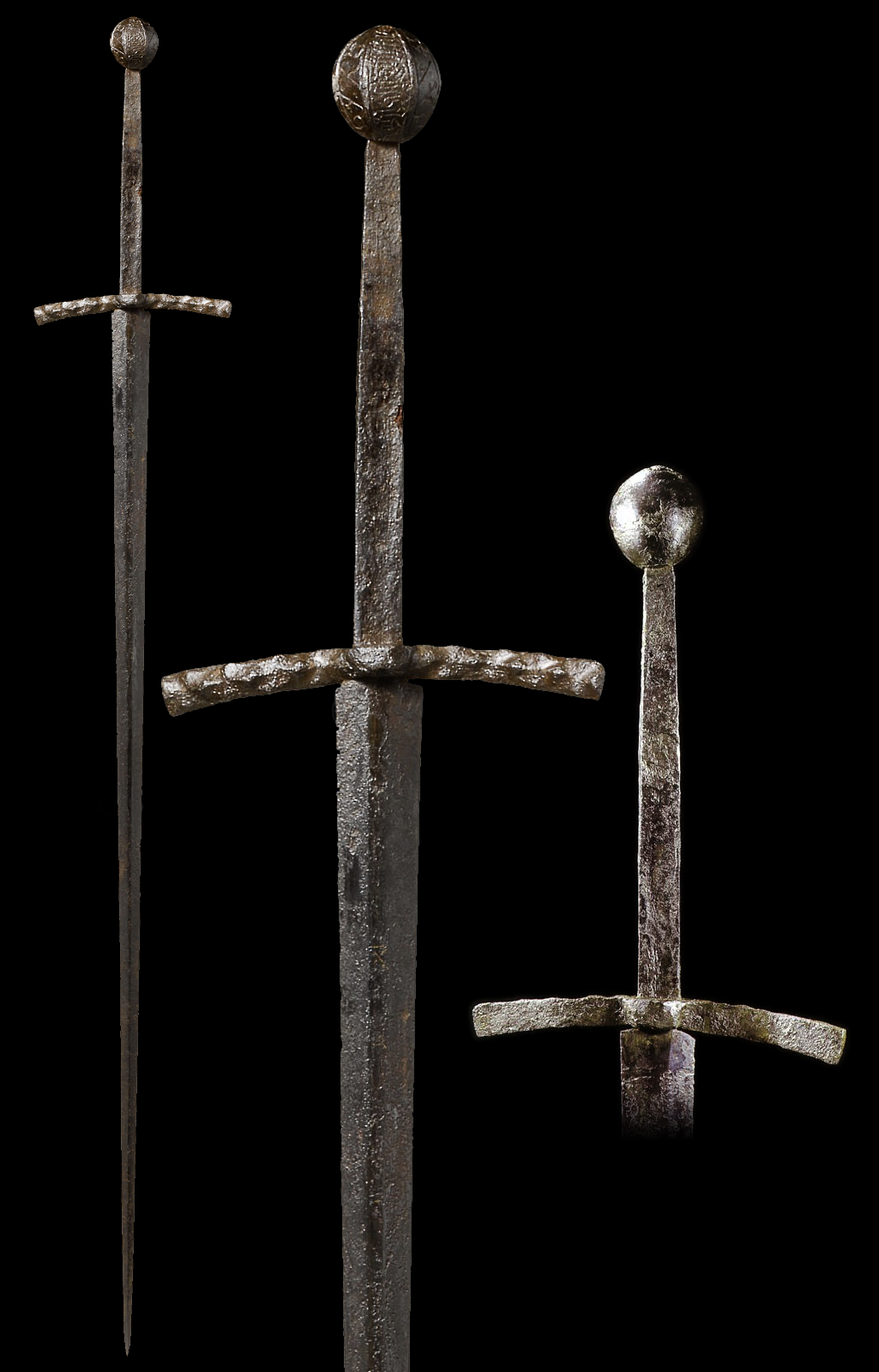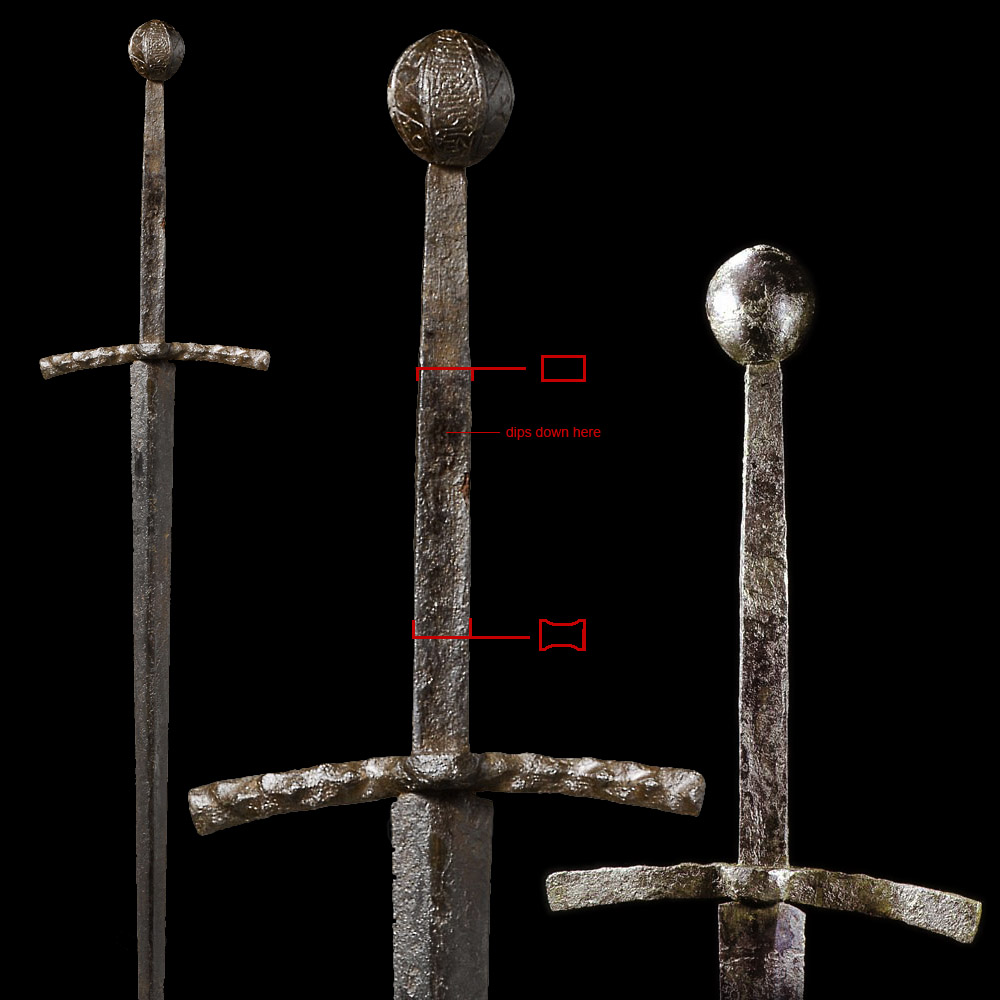| Author |
Message |
Allen Andrews

|
 Posted: Sat 02 Feb, 2008 7:22 am Post subject: Posted: Sat 02 Feb, 2008 7:22 am Post subject: |
 |
|
| Jared Smith wrote: | | Dimensionally, this sword is a lot like the Albion Munich (Bayerisches sword.) Since it has a fuller, I would guess it to be lighter (than 3 lbs 4 ounces.) In my opinion, with that grip, it would be agile and very fast! |
Reading earlier posts I believe it was decided that the sword didn't have a fuller, but the spine was flat causing a hexagonal cross section, and that it was merely a trick of light/shadows that made it appear to have a fuller. I have to admit I didn't read ALL the posts though 
" I would not snare even an orc with a falsehood. "
Faramir son of Denethor
Words to live by. (Yes, I know he's not a real person)
|
|
  |
 |
Chad Arnow
myArmoury Team


|
 Posted: Sat 02 Feb, 2008 8:56 am Post subject: Posted: Sat 02 Feb, 2008 8:56 am Post subject: |
 |
|
This starting to get off-topic, as the sword discussed in this post is not of the Sempach family, but....
Oakeshott wrote an article on these swords in a Park Lane Arms Fair catalogue years ago. He gave stats for 10 different Sempach family swords. The forums doesn't handle charts well, but here is the format (all measurements in cm's):
Location: Length overall; length of blade; width of blade; length of tang; width of cross:
Aarau (von Tarant): 99, 75, 3.7, 24, 22.5
Aarau (von Greiffenstein): 97, 77, 4.5, 20, 19.5
Copenhagen 1: 129.5, 92.5, 4.2, 21, 24
Copenhagen 2: 120.6, 95, 3.8, 18.5, 18.5
Copenhagen 3: 122, 90.8, 5.5, 24.7, 27
Zurich: 92.5, ?, ?, ?, 17.5
Bern: 104.3, 82.5, 4.1, ?, 21.6
London (Wallace Collection): ? 60 (+12.7 missing), 4.8,?, ?
Fitzwilliam: 105.5, 86.6, 3.7, 23.7, 32.3
Private Collection (UK): 114, 88.7, ?, 25, 20.2

ChadA
http://chadarnow.com/
|
|
    |
 |
Nathan Robinson
myArmoury Admin


|
|
    |
 |
Nathan Robinson
myArmoury Admin


|
 Posted: Mon 29 Sep, 2014 2:25 pm Post subject: Posted: Mon 29 Sep, 2014 2:25 pm Post subject: |
 |
|
I recently shared this sword on the myArmoury.com Facebook page. I'm bumping it here in case newer myArmoury.com members haven't seen it. It's a beauty!

| Quote: | Hand-and-a-Half Oakeshott Type XVII Sword, circa 1400–1430
Probably German
This sword is an extremely well proportioned and elegant example of a type that was in use throughout Western Europe from the late fourteenth through the fifteenth century. The steeply pointed blade, indicating that it was primarily intended for thrusting (rather than cutting), coupled with the stiffness of the blade, made it sturdy enough for its primary function, to pierce armor. The sword's form is further enhanced by the slight horizontal reverse curve and dimpled decoration of the cross guard and the faceted and engraved outer face of the pommel, which bears the word "MARIA," a pious invocation to the Virgin Mary. The spherical shape of the pommel and reverse curve of the cross guard are very unusual and distinctive features for a sword of this period with this type of blade.
Medium: Iron, copper alloy
Credit: Gift of Laird and Kathleen Landmann, in memory of Edmund Roy Hofmann, 2006
Accession Number: 2006.564
Overall length: 49 1/8 in. (124.8 cm); Blade length: 38 1/2 in. (97.8 cm); Weight:. 3 lb. 7 oz. (1560 g)
http://www.metmuseum.org/collection/the-colle...arch/27966
Copyright © 2000–2014 The Metropolitan Museum of Art
~~~
With an egg-shaped pommel engraved on its faceted outer face with the name maria in gothic minuscule characters between panels of scrolls, horizontally recurved and gently arched quillons of flattened triangular section, widening very slightly to their ends and decorated on their outer face with a series of pinched medial ridges, long tang struck with a maker's mark formed of a pair of crossed axes within a circle, and a long tapering blade of flattened hexagonal section at the forte and of flattened diamond section for the remainder of its length, inlaid in latten on each side of the forte with a series of maker's marks involving crossed swords.
This outstanding and beautifully preserved weapon, found in a tomb near Breslau, Silesia, in the late 1930s, is of a kind classified by Oakeshott, on the basis of the shape and proportions of its blade, as Type XVII: arguably the most elegant of all forms of Medieval sword. The earliest unequivocal evidence for the use of the type is provided by two examples in the Kantonales Antiquarium, Aarau, Switzerland, which were obtained from the graves of the Austrian knights Friedrich von Tarant and Friedrich von Griffenstein who fell in the Battle of Sempach in 1386.
Evidence for its continuing use in the first half of the following century is provided by an example formerly in the Christensen Collection, Copenhagen, which bears an Arabic inscription recording its deposition as war-booty in the arsenal at Alexandria in 1427; see No. 4 in this catalogue. One of the latest and largest weapons of the type is the 'Pearl' sword of the City of Bristol, which bears an inscription recording its presentation to the city by Sir John de Wells during his term as Mayor of London in 1431. The present example rivals it not only in size, but also in quality.
A particularly attractive feature of the sword under discussion is the engraved decoration of its pommel, including the name 'Maria', invoking the support of the Virgin Mary. The pommel is unusual among Medieval examples in being of egg-shaped form, but can be paralleled by one featured on a bronze statue of David in the Museo Bargello, Florence, sculpted by Donatello about 1430-32. It might indeed be viewed as a somewhat rounded version of the faceted 'scent-stopper' type of pommel used from about 1390-1445, and particularly popular in the period 1400-40.
The quillons of the sword under discussion are notable for being forged on their outer face with a series of pinched ridges. Relief-decorated quillons were of the greatest rarity in the Middle Ages. The earliest recorded examples, formed as ragged staves, are those occurring on a sword in the Historisches Museum, Dresden, given to the Prince Elector Friedrich I of Saxony by the Emperor Sigismund I in 1425, and probably made in Hungary in the period 1419-25. Very similar to the quillons of the present sword in both shape and cross-section are those of a sword in the Musee de Cluny, Paris, identified as that of the Emperor Friedrich III (1415-1440-1493). These are decorated on their outer face with transverse raised and recessed bands. Plain quillons of the same slightly spatulate, medially ridged form can be seen on eight swords in the Askeri Museum, Istanbul. These bear Arabic inscriptions indicating that they were deposited in the arsenal at Alexandria in the period 1401-08. Taking all of its features into consideration, the sword shown here is most likely to have been made in the earliest decades of the 15th century.
Swords of Oakeshott's Type XVII are notable for their weight, and have been likened to 'stout, sharp-pointed bars'. They were quite clearly devised as a dual-purpose weapon that would be capable both of crushing and of piercing the gaps in the full plate armour that was then coming into widespread use. The present impressively proportioned weapon, approaching in size that of a two-handed sword, is not only an unusually attractive example of its kind, but must in its day have been an effective and extremely formidable one to meet in conflict.
Literature: Oakeshott, E. The Sword in the Age of Chivalry, Woodbridge, Suffolk, 1994.
Copyright © 2001 Peter Finer |
 Attachment: 623.98 KB Attachment: 623.98 KB
Hand-and-a-Half Oakeshott Type XVII Sword, circa 1400–1430
Probably German [ Download ]
.:. Visit my Collection Gallery :: View my Reading List :: View my Wish List :: See Pages I Like :: Find me on Facebook .:.
|
|
    |
 |
|
James Moore
|
 Posted: Mon 29 Sep, 2014 5:36 pm Post subject: Posted: Mon 29 Sep, 2014 5:36 pm Post subject: |
 |
|
here's a little something that I don't think anyone's noted yet...
there was discussion of it having a fuller - well, it certainly doesn't have any of them on the blade, that's certainly a hex section.
but it does look like the tang has a subtle hollowing or fuller on the decorated side, and plausibly on the other side too..
here's a masterpiece of fine art to show what I'm seeing:
opinions?

 Attachment: 156.34 KB Attachment: 156.34 KB
[ Download ]
|
|
  |
 |
Nathan Robinson
myArmoury Admin


|
|
    |
 |
|
Dustin R. Reagan
|
 Posted: Tue 30 Sep, 2014 1:15 pm Post subject: Posted: Tue 30 Sep, 2014 1:15 pm Post subject: |
 |
|
| Nathan Robinson wrote: | | That's certainly an interesting observation! |
This is (most likely) simply an artifact of the forging process. What we call 'fish-lips'. hammering the edges of a hot bar cause the faces of the bar in contact with the hammer and the anvil to mushroom out & deform at a faster rate than the center of the bar...especially with a lighter hammer. It's very easy to 'fix', but unnecessary and/or even desirable on a tang.
|
|
  |
 |
|
|
You cannot post new topics in this forum
You cannot reply to topics in this forum
You cannot edit your posts in this forum
You cannot delete your posts in this forum
You cannot vote in polls in this forum
You cannot attach files in this forum
You can download files in this forum
|
All contents © Copyright 2003-2025 myArmoury.com — All rights reserved
Discussion forums powered by phpBB © The phpBB Group
Switch to the Basic Low-bandwidth Version of the forum
|

